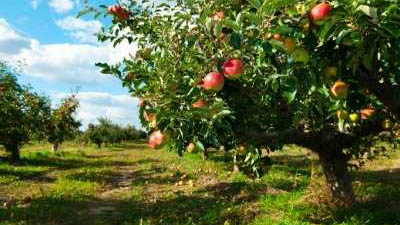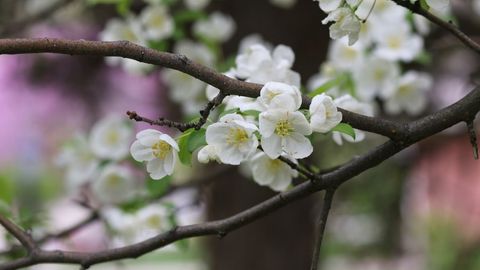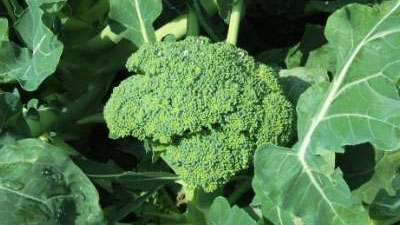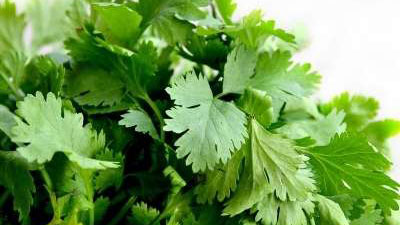How to Grow Garlic in Your Garden
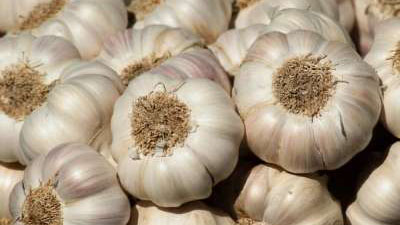
Garlic is a hardy perennial that grows best in full sun and fertile, well drained soils. Incorporate plenty of organic matter and a complete fertilizer to the soil before planting. Plant garlic from late September to November. Plant cloves 2-3 inches deep, in rows 6-10 inches apart, with cloves 3-4 inches apart in the row. Side-dress with nitrogen in May to ensure good growth and high yields. Keep soils moist and use mulches to conserve water, supply extra nutrients and reduce weeding. Harvest garlic when the tops are yellow but before they are dry. Check with local garden centers and seed catalogs for variety availability.
Garlic Varieties
Two types of garlic are commonly grown in home gardens; the hardneck and softneck (Allium sativum) types and elephant (Allium ampeloprasum) garlic. Hardneck types have shorter store life and a long stem growing up through the bulb, while softneck types store very well and are preferred for braiding. Elephant garlic is very mild, stores poorly and is more closely related to leek than garlic. Check with local garden centers or seed catalogs for specific varieties.
How to Grow Garlic
Soils
Garlic grows in all soil types provided they are rich in organic matter, well drained, moist, and fertile.
Soil Preparation
Before planting, determine fertilizer needs with a soil test and then follow the recommendations given with the test report. If fertilizer applications are warranted, work the fertilizer into the top 6 inches of soil. If you fertilize with compost, apply no more than 1 inch of well-composted organic matter per 100 square feet of garden area
Plants
Garlic can be planted from mid-September through early November. Bulb growth is poor and yields low if planted in the spring. During the fall and winter, the root system develops even though little top growth occurs. Tops grow rapidly the following spring. Large tops are required to produce large bulbs. Garlic is grown from clean, disease-free, well-developed bulbs. Carefully break bulbs apart into individual cloves. Plant the largest unpeeled cloves with the pointed end up 2-3 inches deep. If a flowering stem forms during the year, it can be cut off to redirect more energy to the bulb.
Planting and Spacing
Cloves should be spaced 3-4 inches apart in the row, with rows 6-10 inches apart. High-density plantings will reduce bulb size unless adequate water and nutrients are supplied.
Water
Garlic require regular watering for best growth and production. Moisten the soil thoroughly to a depth of 12 inches and use drip irrigation if possible. Water needs are critical since rooting depth in garlic is shallow. Drought stress during growth decreases yield and reduces bulb size. Stop watering when the leaves start to mature (turn yellow). Excess water as the crop matures delays curing and causes storage problems.
Fertilization
In addition to the fertilizer used at planting, garlic needs additional nitrogen fertilizer to produce optimum yields. Side-dress with ½ pounds of nitrogen fertilizer (21-0-0) per 100 square feet in midApril and ¼ pounds in late May.
Mulches
Organic mulches help conserve water, supply extra nutrients and reduce weeding. Mulches are also used to protect garlic during the winter.
Problems with Growing Garlic
Weeds
Control weeds by regular shallow cultivation, but avoid root damage that slows plant growth. Weed control is particularly important during the first 2 months of growth when plants are growing slowly. Mulching with compost, grass clippings or leaves will smother weeds.
Insects and Diseases
For additional information on insect and diseases visit the Utah Pests website.
| Insect | Identification | Control |
|---|---|---|
| Thrips | Tiny, slender insects that feed on leaves. Leaves turn silver or gray, may twist and die. Thrips hide near where the leaf and bulb meet. | Thrips are best managed with cultural practices and natural biological control. Add compost, use mulches or apply a stiff spray of water to wash thrips from plants |
| Onion Maggot | White worm that feeds on seedlings, roots or bulbs. | Use crop rotation, avoid excessive amounts of organic matter, and apply insecticides at planting if maggots have been a problem in the past. Destroy infected plants. |
| Disease | Symptom | Control |
|---|---|---|
| Neck Rot | Fungal disease that occurs during storage. Watery Decay inside the bulb. | Avoid excess moisture near harvest. Cure bulbs well before storing |
How to Harvest and Store Garlic
Harvest garlic when the tops begin to yellow or start to fall over, but before they are completely dry. Carefully lift the bulbs with a spade or garden fork. Over mature bulbs are open and do not store well. Place the entire plant in a shady warm spot to dry for 1-2 weeks. When fully cured the garlic skins should be papery and the roots dry. Carefully remove any excess soil from the roots and bulbs. Mature bulbs may be braided into garlic ropes or stored in open meshed sacks. For stored bulbs, cut off the leaves 1-2 inches above the bulb. Store garlic in cool (32-40°F), dry conditions. Avoid freezing. The largest, healthiest bulbs may be used for the next planting.
Garlic Plant Productivity
Each planted clove will produce one bulb. Each bulb should yield 10-15 cloves at harvest.
Garlic Nutrition Facts
Garlic is very low in Saturated Fat, Cholesterol and Sodium. It is also a good source of Calcium and Phosphorus, and a very good source of Vitamin C and Vitamin B6.
Frequently Asked Questions
Can you plant garlic in the spring?
Yes. While fall planting is preferred, you can get good results with spring planting. In Utah, spring plantings generally produces small bulbs. Plant the cloves as soon as the soil can be worked in the spring.
How can you remove garlic odor from your breath?
The easiest way of handling "garlic breath" is to be sure everyone is eating garlic. Otherwise, try chewing on a sprig fresh parsley. It masks garlic breath and is good for you, too.
Published May 2020
Utah State University Extension
Peer-reviewed fact sheet
Download PDF
Authors
Dan Drost, Vegetable Specialist
Related Research


